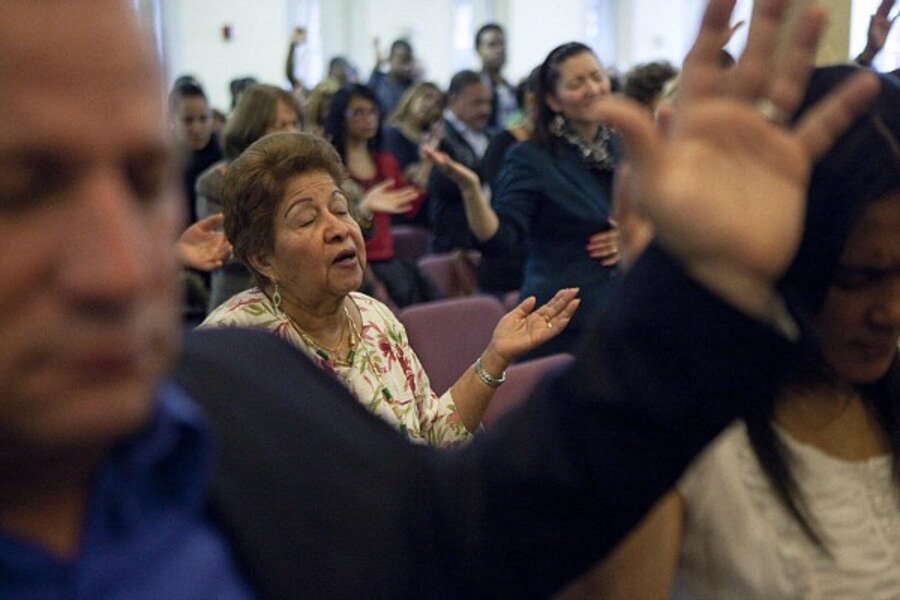How religion in the US today tracks closely with geography
Loading...
Tell me where you live, and there’s a good chance I’ll know your religion.
Mississippi or Alabama? Protestant. Rhode Island or New Jersey? Roman Catholic. Mormon? That’s easy: Utah, although a substantial minority in Idaho is Mormon too. Vermont or Oregon? You could well be "unchurched."
Demography isn’t exactly spiritual destiny. But for most Americans, their religious identity tracks closely with where they live.
If they’re Protestant, they’re more likely to live in the South. Seven of the ten most-Catholic states, on the other hand, are in the Northeast – although California and New Mexico, with heavily Hispanic populations, have large numbers of Catholics as well.
These are some of the findings in a new Gallup survey.
“All 10 of the most Protestant states are located in the South,” Gallup reported this week. “Nine of these states are at least 70 percent Protestant, including the two most highly Protestant states, Mississippi and Alabama, each with a 77 percent Protestant population.”
“Two other religious groups that are much smaller constitute about 2 percent of the population each, with Mormons concentrated in Utah and Idaho, and Jewish Americans most likely to be found in several Middle Atlantic and New England states, plus the District of Columbia,” according to Gallup.
But what about the degree of fervency or devoutness?
Vermont has the smallest percentage of those who identify themselves as “very religious” (just 22 percent) with other New England states – New Hampshire, Maine, and Massachusetts – not far behind.
Mississippi has the highest percentage of “very religious” (61 percent), with Mormon Utah and other Protestant southern states – Alabama, Louisiana, and South Carolina – not far behind.
Increasing numbers of Americans refer to themselves as “spiritual but not religious,” and this shows up in the number of unaffiliated adults queried by Gallup and the Pew Research Center’s Religion and Public Life Project – a figure that’s risen to nearly 20 percent in the most recent Pew survey (2012).
It’s a figure that’s likely to grow as the generations move on.
“A third of adults under 30 have no religious affiliation (32 percent), compared with just one-in-ten who are 65 and older (9 percent),” Pew reported. “And young adults today are much more likely to be unaffiliated than previous generations were at a similar stage in their lives.”
A key question: Will today’s “millennials” retain that attitude later in life, or will they “find religion” – at least a generally accepted denomination – as they advance in years?
There may be an important political dimension paralleling if not attributable to shifting religious attitudes.
“In the 2008 presidential election, [the religiously unaffiliated] voted as heavily for Barack Obama as white evangelical Protestants did for John McCain,” according to Pew. “More than six-in-ten religiously unaffiliated registered voters are Democrats (39 percent) or lean toward the Democratic Party (24 percent). They are about twice as likely to describe themselves as political liberals than as conservatives, and solid majorities support legal abortion (72 percent) and same-sex marriage (73 percent).”
Meanwhile, two-thirds of Americans – affiliated and unaffiliated alike – say religion is losing its influence in Americans’ lives, Pew reported last year.
At the same time, the US – founded by those looking for a religious freedom they had not known in Europe, and despite the growth in atheism and agnosticism – remains more religious than most other western countries.
A majority continues to say that religion is very important in their lives – much higher than Britain (17 percent), France (13 percent), Germany (21 percent), or Spain (22 percent). And 76 percent say that prayer is an important part of their daily life – the same level as in 1987, Pew finds.
Self-described Protestants may still be a majority of religious Americans (although that percentage has slipped to barely more than half). But their influence at the top levels of government continues to wane.
Between 1961 and 2014, the percentage of Protestants in Congress dropped from 75 percent to 56 percent. Over the same period, the percentage of Catholic lawmakers in Washington rose from 19 percent to 31 percent, and the percentage of Jewish members tripled from 2 percent (in line with the overall US population) to 6 percent.
The current Congress also includes the first Buddhist to serve in the Senate, the first Hindu to serve in either chamber and the first member of Congress to describe her religion as “none.”
On the US Supreme Court, in its early days a largely WASP institution, there are no Protestant justices today. Six are Catholic and three are Jewish.






